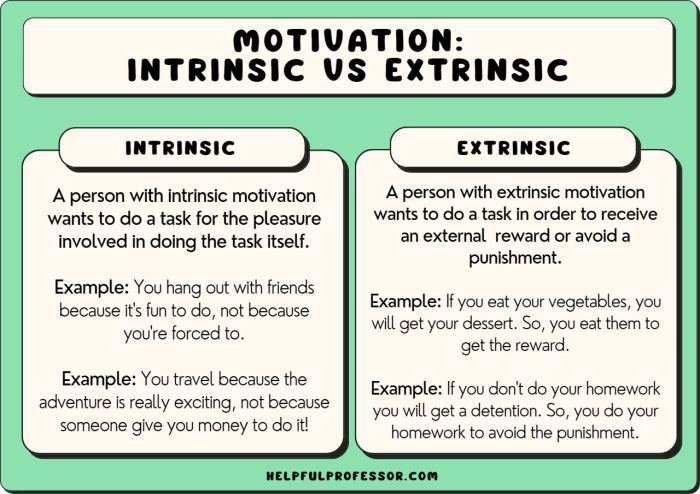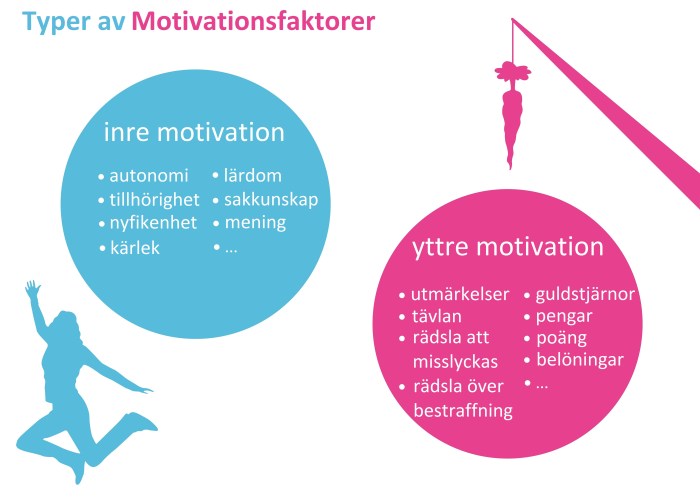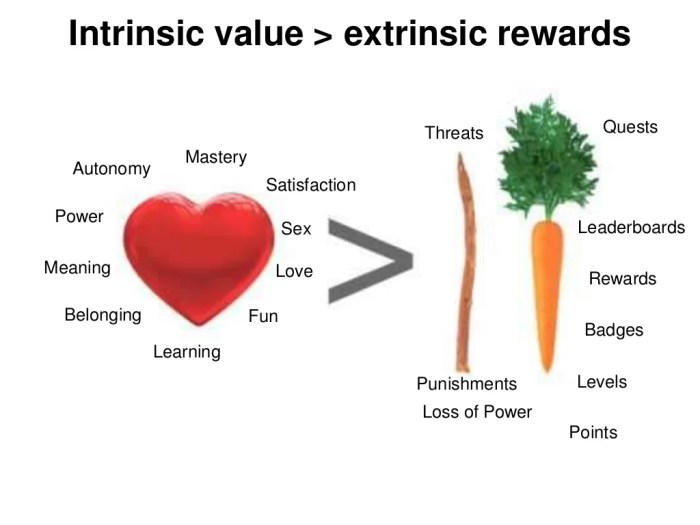Which of the following exemplifies an intrinsic reward? This question delves into the captivating realm of motivation, exploring the profound impact of activities that provide inherent satisfaction and fulfillment. Intrinsic rewards, unlike their extrinsic counterparts, stem from the very nature of the task itself, offering a deep sense of purpose and accomplishment.
Intrinsic rewards encompass a vast spectrum of experiences, ranging from the exhilaration of mastering a skill to the contentment of contributing to a meaningful cause. They fuel our motivation, driving us to engage in activities not for external recognition or tangible rewards, but for the sheer joy and fulfillment they bring.
Understanding Intrinsic Rewards

Intrinsic rewards are internal motivators that drive individuals to engage in activities for their own inherent satisfaction, without the expectation of external rewards or recognition. Unlike extrinsic rewards, which are tangible or external incentives, intrinsic rewards come from within and are associated with a sense of accomplishment, purpose, and enjoyment.
Examples of activities that can provide intrinsic rewards include pursuing hobbies, learning new skills, engaging in creative endeavors, and contributing to a cause or community.
Types of Intrinsic Rewards

There are various types of intrinsic rewards that can contribute to motivation and well-being, including:
Autonomy
The freedom to make choices and control one’s own actions can provide a sense of autonomy and self-determination, which can be highly motivating.
Mastery
The process of developing skills and achieving competence in a particular area can provide a sense of mastery and accomplishment, which can lead to increased motivation and engagement.
Purpose
Engaging in activities that align with one’s values and goals can provide a sense of purpose and meaning, which can be a powerful intrinsic reward.
Examples of Intrinsic Rewards
| Activity | Description | Type of Reward |
|---|---|---|
| Learning a new language | Expanding knowledge and skills, sense of accomplishment | Mastery |
| Volunteering for a charity | Making a positive contribution, sense of purpose | Purpose |
| Playing a musical instrument | Expressing creativity, sense of joy | Autonomy |
| Gardening | Nurturing nature, sense of accomplishment | Mastery |
| Spending time with loved ones | Building relationships, sense of connection | Autonomy |
Benefits of Intrinsic Rewards

Intrinsic rewards have several positive effects on individuals, including:
- Increased Motivation:Intrinsic rewards can drive individuals to engage in activities for their own enjoyment, rather than relying solely on external incentives.
- Enhanced Engagement:Activities that provide intrinsic rewards are more likely to capture and sustain attention, leading to greater engagement and focus.
- Improved Productivity:When individuals are intrinsically motivated, they are more likely to put forth effort and achieve higher levels of productivity.
- Overall Well-being:Engaging in activities that provide intrinsic rewards can contribute to overall well-being, happiness, and life satisfaction.
Fostering Intrinsic Rewards
Intrinsic rewards can be fostered in various settings, including:
Education
- Providing students with choices and autonomy in their learning.
- Setting clear and achievable goals to foster a sense of mastery.
- Connecting learning to real-world applications to create a sense of purpose.
Workplace
- Empowering employees with decision-making authority.
- Providing opportunities for skill development and growth.
- Recognizing and rewarding employee contributions to foster a sense of purpose.
Personal Life, Which of the following exemplifies an intrinsic reward
- Pursuing hobbies and interests that bring joy and satisfaction.
- Setting personal goals and striving to achieve them.
- Engaging in activities that contribute to the community or environment.
Intrinsic Rewards in Different Cultures

The perception and value of intrinsic rewards can vary across cultures. Cultural norms and values influence the types of activities that provide intrinsic rewards in different societies.
For example, in some cultures, autonomy and independence are highly valued, while in others, a sense of community and interdependence is more important. These cultural differences shape the activities that individuals find intrinsically rewarding.
Intrinsic Rewards in the Digital Age
Technology and the digital environment play a significant role in shaping intrinsic rewards. Digital experiences and interactions can provide opportunities for intrinsic motivation.
For example, online learning platforms can offer autonomy and mastery by allowing learners to set their own pace and progress at their own level. Social media platforms can foster a sense of purpose by connecting individuals with like-minded communities and providing opportunities for self-expression.
Q&A: Which Of The Following Exemplifies An Intrinsic Reward
What are the key characteristics of intrinsic rewards?
Intrinsic rewards are characterized by their inherent value, providing satisfaction and fulfillment independent of external factors.
How do intrinsic rewards differ from extrinsic rewards?
Intrinsic rewards stem from the activity itself, while extrinsic rewards are contingent on external factors such as praise or monetary compensation.
What are some examples of intrinsic rewards?
Examples of intrinsic rewards include the joy of learning, the satisfaction of completing a challenging task, and the sense of accomplishment from contributing to a meaningful cause.